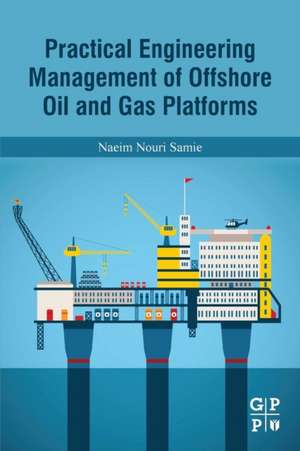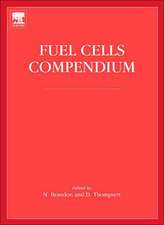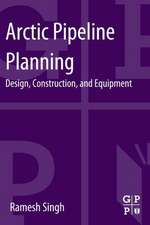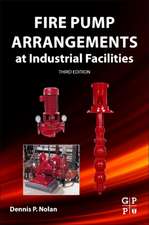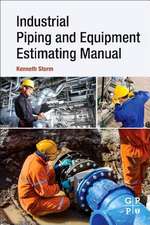Practical Engineering Management of Offshore Oil and Gas Platforms
Autor Naeim Nouri Samieen Limba Engleză Paperback – 9 mai 2016
Concepts explaining how to interact with the various task forces, getting through bid proposals, and how to maintain project control are all covered in the necessary training reference. Relevant equipment and rule of thumb techniques to calculate critical features on the design of the platform are also covered, including tank capacities and motor power, along with how to consistently change water, oil, and gas production profiles over the course of a project.
The book helps offshore oil and gas operators and engineers gain practical understanding of the multiple disciplines involved in offshore oil and gas projects using experience-based approaches and lessons learned.
- Delivers the first ever must-have content to the multiple engineering managers and clients devoted to the design, equipment, and operations of offshore oil and gas platforms
- Contains rules of thumb techniques to calculate critical features on the design of the platform
- Includes practical checklists for project estimates and cost evaluation for effective project execution in budgeting and scheduling
- Helps offshore oil and gas operators and engineers gain practical understanding of the multiple disciplines involved in offshore oil and gas projects using experience-based approaches and lessons learned
Preț: 447.97 lei
Preț vechi: 486.93 lei
-8% Nou
Puncte Express: 672
Preț estimativ în valută:
85.75€ • 93.17$ • 72.07£
85.75€ • 93.17$ • 72.07£
Carte tipărită la comandă
Livrare economică 14-28 aprilie
Preluare comenzi: 021 569.72.76
Specificații
ISBN-13: 9780128093313
ISBN-10: 0128093315
Pagini: 574
Ilustrații: 100 illustrations
Dimensiuni: 152 x 229 x 33 mm
Greutate: 0.84 kg
Editura: ELSEVIER SCIENCE
ISBN-10: 0128093315
Pagini: 574
Ilustrații: 100 illustrations
Dimensiuni: 152 x 229 x 33 mm
Greutate: 0.84 kg
Editura: ELSEVIER SCIENCE
Cuprins
Preface
Part I: Engineering Design of Offshore Platforms
Ch 1: Introduction to Offshore Platforms
1.1 Offshore Platform History
1.2 Oil and Gas Offshore Platforms Types
1.3 Importance of Engineering
1.4 Engineering Practice
Ch 2: Disciplines Involved in Offshore Platform Design
2.1 Architectural
2.2 Control
2.3 Electrical
2.4 HVAC
2.5 Instrument
2.6 Mechanical
2.7 Piping
2.8 Process
2.9 Safety
2.10 Structure
2.11 Telecommunication
Ch 3: Systems and Equipment for Offshore Platform Design
3.1 Process Systems
3.2 Utility Systems
3.3 Instrumentation and Control Systems
3.4 Safety Systems
3.5 Accommodation Systems
Part II: Management, Budgeting, and Scheduling of Offshore Platform Design
Ch 4: Balancing between Client and Task Force Engineers
4.1 Client Requests
4.2 Engineering Team Requirements
4.3 Disciplines/Engineers Mobilization and Requests
Ch 5: Handling Design Documentation
5.1 Master Document Register (MDR)
5.2 Interdisciplinary Checks / Discipline Interfaces
5.3 Document Control Center (DCC)
5.4 Vendor Data Controller (VDC)
5.5 Engineering Disciplines
5.6 General Items to be Checked in Quotation
5.7 Planning Department
Ch 6: Proposal Preparation
6.1 Familiarizing with Proper Requirements
6.2 Approximate Costs
6.3 Proposal Preparation Organization
6.4 Man Hour Weight Distribution
6.5 Unit Costs Calculation
6.6 Miscellaneous Costs
6.7 Changes / Variation Orders
Ch 7: Planning the Project Budget
7.1 Introduction
7.2 Budget Proposal
7.3 Monthly Planning
7.4 Expected Income and Deficits
7.5 Expected Deviations
7.6 Proposals and Incentives
References
Index
Part I: Engineering Design of Offshore Platforms
Ch 1: Introduction to Offshore Platforms
1.1 Offshore Platform History
1.2 Oil and Gas Offshore Platforms Types
1.3 Importance of Engineering
1.4 Engineering Practice
Ch 2: Disciplines Involved in Offshore Platform Design
2.1 Architectural
2.2 Control
2.3 Electrical
2.4 HVAC
2.5 Instrument
2.6 Mechanical
2.7 Piping
2.8 Process
2.9 Safety
2.10 Structure
2.11 Telecommunication
Ch 3: Systems and Equipment for Offshore Platform Design
3.1 Process Systems
3.2 Utility Systems
3.3 Instrumentation and Control Systems
3.4 Safety Systems
3.5 Accommodation Systems
Part II: Management, Budgeting, and Scheduling of Offshore Platform Design
Ch 4: Balancing between Client and Task Force Engineers
4.1 Client Requests
4.2 Engineering Team Requirements
4.3 Disciplines/Engineers Mobilization and Requests
Ch 5: Handling Design Documentation
5.1 Master Document Register (MDR)
5.2 Interdisciplinary Checks / Discipline Interfaces
5.3 Document Control Center (DCC)
5.4 Vendor Data Controller (VDC)
5.5 Engineering Disciplines
5.6 General Items to be Checked in Quotation
5.7 Planning Department
Ch 6: Proposal Preparation
6.1 Familiarizing with Proper Requirements
6.2 Approximate Costs
6.3 Proposal Preparation Organization
6.4 Man Hour Weight Distribution
6.5 Unit Costs Calculation
6.6 Miscellaneous Costs
6.7 Changes / Variation Orders
Ch 7: Planning the Project Budget
7.1 Introduction
7.2 Budget Proposal
7.3 Monthly Planning
7.4 Expected Income and Deficits
7.5 Expected Deviations
7.6 Proposals and Incentives
References
Index
